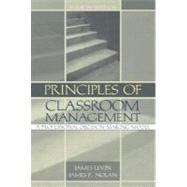
All chapters begin with “The Hierarchy,” “Principles of Classroom Management,” and “Introduction.” All chapters conclude with “Summary,” “References,” and “Exercises.”
Preface to the Fourth Edition.
Preface to the Third Edition.
Preface to the Second Edition.
Preface to the First Edition.
I. Foundations.
1. The Basics.
Defining the Process of Teaching.
Case 1.1: Getting Students to Respond.
Case 1.2: “Why Study? We Don't Get Enough Time for the Test Anyway!”
Principles of Classroom Management.
Professional Decision-Making Hierarchy.
Case 1.3: The Vice-Principal Wants to See Whom?
2. Nature of the Discipline Problem.
Defining a Discipline Problem.
Case 2.1: Can a Teacher Be a Discipline Problem?
Case 2.2: Solving a Motivational Problem.
Extent of the Problem.
The Effect of Classroom Discipline Problems on Teaching and Learning.
Case 2.3: Discipline: A Costly Waste of Time.
Case 2.4: The Ripple Effect.
3. Understanding Why Children Misbehave.
Societal Changes.
Case 3.1: This Is the Greatest Thing That Has Happened to Me in Twenty Years of Teaching.
Case 3.2: Who Really Cares?
Failure to Meet Children's Basic Needs.
Case 3.3: Hanging on the Corner.
Case 3.4: Marital Conflict.
Case 3.5: Forgetting to Sit Down.
Case 3.6: There Must Be a Better Way.
Case 3.7: Too Much Noise.
Case 3.8: Afraid of Going to School.
Case 3.9: Turning Off Students.
Case 3.10: I'm Going to Be Sorry When Fifth Grade Is Over.
Children's Pursuit of Social Recognition and Self-Esteem.
Case 3.11: Seeking Faulty Goals.
Stages of Cognitive and Moral Development.
Case 3.12: “Get out of My Face.”
Instructional Competence.
Case 3.13: Not Being Able to Teach.
4. Philosophical Approaches to Classroom Management.
Case 4.1: The Tricks-of-the-Trade Approach.
Teacher Power Bases.
Case 4.2: The Involved Teacher.
Case 4.3: Her Reputation Precedes Her.
Case 4.4: “School Is Your Job.”
Case 4.5: Going to Recess.
Theories of Classroom Management.
Case 4.6: Handling Disruptive David.
II. Prevention.
5. The Professional Teacher.
The Basics of Effective Teaching.
Case 5.1: The Popcorn Popper.
Case 5.2: Talking between Classes.
Case 5.3: Nonconstructive Feedback.
Beyond the Basics.
Case 5.4: Cooperative Learning in Biology.
Case 5.5: Three Years of History Rolled into One.
6. Structuring the Environment.
Designing the Physical Classroom Environment.
Establishing Classroom Guidelines.
Case 6.1: Fourteen to Ten, Music Wins.
Case 6.2: Having Your Name Placed on the Board Isn't Always Bad.
Case 6.3: “I Don't Know if I Can Remember.”
Case 6.4: “I'm Not Promising Anything.”
Case 6.5: Calling out Correct Answers.
Case 6.6: The Smiley Face Self-Analysis.
The Cultural Embeddedness of Rules and Guidelines.
Creating Group Norms to Structure Appropriate Behavior.
III. Managing Common Misbehavior Problems.
7. Coping With Common Misbehavior Problems: Nonverbal Interventions.
Prerequisites to Management.
Surface Behaviors.
Case 7.1: “ 3,2,1, Blast Off.”
Proactive Intervention Skills.
Remedial Intervention Skills.
Effectiveness of Nonverbal Coping Skills.
Case 7.2: Notes versus Math.
Case 7.3: Let Your Fingers Do the Walking.
8. Coping With Common Misbehavior Problems: Verbal Interventions and Use of Logical Consequences.
Case 8.1: Blowing His Stack.
Classroom Verbal Intervention.
Case 8.2: Jimmy, the Little Sneak.
Comply or Face the Logical Consequences: “You Have a Choice.”
When “You Have a Choice” Doesn't Work.
Case 8.3: “Doing Nothin'.”
IV. Solving Chronic Behavior Problems.
9. Classroom Interventions for Chronic Problems.
Case 9.1: “I Just Dropped My Book.”
Relationship Building.
Case 9.2: Darnell.
Case 9.3: Relating to Cindy.
Breaking the Cycle of Discouragement.
Short-Term Problem Solving Techniques.
10. Seeking Outside Assistance.
The Nature of Persisting Misbehavior.
When Outside Assistance Is Needed.
The Referral Process.
Working with Parents.
Case 10.1: “In Order to Drive, You Must Speak Spanish.”
Case 10.2: “Won't Be Much Help.”
Symptoms of Serious Problems.
Legal Aspects of Seeking outside Assistance.
Appendix: The Discipline Problem Analysis Inventory (DPAI).
Part I: Have I Done All I Can to Prevent Misbehavior?
1. The Basics.
2. Nature of the Discipline Problem.
3. Understanding Why Children Misbehave.
4. Philosophical Approaches to Classroom Management.
5. The Professional Teacher.
6. Structuring the Environment.
Part II: Am I Effectively Resolving Misbehavior?
7. Coping With Common Misbehavior Problems: Nonverbal Intervention.
8. Coping With Common Misbehavior Problems: Verbal Interventions and Use of Logical Consequences.
9. Classroom Interventions for Chronic Problems.
10. Seeking Outside Assistance.
Index.
The New copy of this book will include any supplemental materials advertised. Please check the title of the book to determine if it should include any access cards, study guides, lab manuals, CDs, etc.
The Used, Rental and eBook copies of this book are not guaranteed to include any supplemental materials. Typically, only the book itself is included. This is true even if the title states it includes any access cards, study guides, lab manuals, CDs, etc.